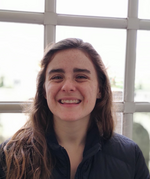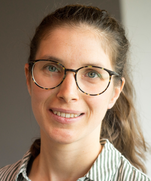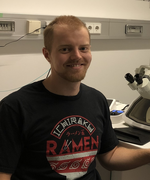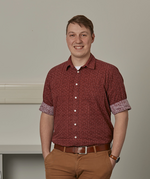Student Speakers
Paulina Cruz de Casas Kastenmüller Lab, Institute of Systems Immunology
Stefanie Ha Eilers Lab, Biochemistry and Molecular Biology
Beatrice Haack Wischhusen Lab, Experimental Tumor Immunology
Fabian Link Engstler Lab, Cell and Developmental Biology
Marcel Rühling Fraunholz Lab, Microbiology
Lukáš Pekárek Caliskan Lab, HIRI
Uddhav Ambi Smyth Lab, HIRI
Sabina Ganskih Munschauer Lab, HIRI
Paulina Cruz de Casas
Kastenmüller Lab, Institute of Systems Immunology
Lymphatic migration of unconventional T cells promotes site-specific immunity in distinct lymph nodes
Lymph nodes (LNs) are secondary lymphoid organs that harbor various cell types, such as dendritic cells (DCs), natural killer (NK) cells, B and T lymphocytes, allowing them to closely interact with each other. In addition, LNs are connected to the lymphatic system, thus they are able to integrate information from the peripheral tissues that they drain, positioning them as essential specialized organs for initiating adaptive immunity. The information received by LNs in the form of metabolites, cytokines, pathogens or microbial products, can be passively drained via the afferent lymphatics. This connection between the LNs and their respective tissues not only initiates and scales an immune response, but also shapes its quality and customizes it to the specific context (e.g. infection or disease) and tissue. Additionally, DCs can migrate from distinct tissues and optimize the polarization and expression of adhesion molecules in the lymphocytes they interact with, thereby adjusting the function of T and B cells and promote their recruitment to the target tissue from which these DCs emigrated. Henceforth, they not only report the tissue status to lymphocytes in the draining LNs (dLNs), but also generate and fine-tune immune responses that are optimized to the tissue that they drain.
Here, we asked whether other immune cells can influence the site-specificity of immune responses, linking tissue immunity to lymph nodes. Surprisingly, we found that unconventional T cells (UTCs) shape the local immune response in a site-specific manner. Using scRNA-sequencing, gene-deficient models, transplantation and photo-conversion experiments, we could show that tissue-derived UTCs similarly migrate via the lymphatic route to locally dLNs. Because each tissue harbors a distinct spectrum of UTCs with locally adapted differentiation states (Th1-like, Th17-like) and distinct TCR repertoires (gd T cells, NKT, MAIT), every dLN is thus populated by a distinctive tissue-determined mix of these lymphocytes. Functionally, UTCs cooperate in interconnected units that generate and shape characteristic innate and adaptive immune responses that differ between LNs that drain distinct tissues. Lymphatic migration of UTCs is therefore a key determinant of site-specific immunity initiated in distinct LNs with potential implications for vaccination strategies and immunotherapeutic approaches.
Stefanie Ha
Eilers Lab, Biochemistry and Molecular Biology
Interactions with RNA shape the MYCN interactome
The MYC family consists of oncogenes whose dysregulation drive the genesis of multiple tumor types. MYCN amplification is associated with high-risk neuroblastoma, where it induces a tumor-specific gene expression and accelerates tumor cell proliferation. This is achieved by MYCN forming a heterodimer with MAX in order to bind active promoters and enhancers and thus regulate transcription. MYC oncoproteins are considered undruggable, because of their largely disordered structure and lack of enzymatic activity, however, interactome analyses show they associate with numerous proteins that could potentially be targeted.
In our recent publication, we show that MYCN recruits the RNA exosome, a 3’-5’ ribonucleolytic complex, to stalled RNA polymerase II (RNAPII) to prevent transcription-replication conflicts and double-strand breaks. This leads to a MYCN-dependent transcription termination which frees the way for productive transcription elongation and reduces the risk of fatal DNA damage.
The RNA exosome plays a central role in RNA quality control, as it degrades cryptic, dysfunctional or mis-folded RNAs. This led us to investigate the interaction between MYCN and RNA and the potential influence of RNAs on modulating the MYCN interactome. Enhanced crosslinking and immunoprecipitation (eCLIP) experiments showed that MYCN associates with a large number of intronic RNAs which are also bound by the RNA exosome. Furthermore, gradient fractionations revealed the existence of two separate MYCN complexes: the known heterodimer with MAX and a high molecular weight complex which contains the exosome and RNAPII. Mass spectrometry of the larger complex revealed a prevalence of RNA binding proteins and an absence of MAX. Knockdown of EXOSC10, a catalytic subunit of the exosome, amplified MYCN-RNA binding and stabilized the formation of the high molecular weight MYCN protein complex. Conversely, rapid degradation of the structural subunit EXOSC5 utilizing the auxin-inducible degron (AID) technology completely abolished the formation of the high molecular weight complex.
Our results reveal a stable MAX-independent MYCN complex that arises from the association of MYCN with exosome-sensitive RNAs. We hypothesize that this complex removes stalled RNAPII from chromatin thus maintaining productive transcription in a large group of genes and ensuring the rapid proliferation of tumor cells.
Beatrice Haack
Wischhusen Lab, Experimental Tumor Immunology
GDF-15 – a cytokine and its immunomodulatory potential
Growth/differentiation factor-15 (GDF-15) is a distant member of the transforming growth factor-b superfamily. Under normal conditions, GDF-15 shows very low constitutive expression in most somatic tissues. However, its expression is induced under stress conditions as well as during pregnancy in the placenta. Moreover, GDF-15 is a biomarker for disease prognosis in cancer. One well-documented function, induction of anorexia, is mediated via the brainstem-restricted GDF-15 receptor GFRAL (glial cell-derived neurotrophic factor [GDNF] family receptor α-like). Still various other roles, such as during pregnancy and tumor progression, cannot be explained via the known mechanism due to the absence of GFRAL on immune cells. Mechanistically, in vitro data show that GDF-15 impairs activation of LFA-1/b2-integrin on T cells, which is critically required for interaction with ICAM expressed by endothelial cells and antigen presenting cells. Thereby, GDF-15 does not only destabilize interactions with DCs during T cell priming, but also their extravasation to tissues and infiltration into tumors. These findings were supported by in vivo data from the MC38 colon cancer and the orthotopic Panc02 pancreatic tumor model. Besides affecting immune cell trafficking, GDF-15 can also skew macrophages towards a more anti-inflammatory, tumor-promoting phenotype. GDF-15 thus induces immune tolerance on many different levels, which supports its targeting for cancer immunotherapy.
Fabian Link
Engstler Lab, Cell and Developmental Biology
The 3D architecture of the Trypanosoma brucei endosomes reveals the structural basis for rapid plasma membrane recycling
Trypanosoma brucei is an extracellular human and livestock pathogen that follows an effective strategy to evade the host immune system. This strategy relies on the periodical change of variant surface glycoproteins (VSGs) that cover the entire cell surface of the parasite. Remarkably, trypanosomes recycle the entire cell surface within in just 12 min. Consequently, this parasite requires to have a highly effective endosomal sorting system.
Currently, the endosomal system in T. brucei is described as distinct compartments that represent the early, late, and recycling endosomes. The Rab GTPases (Rab5 – early endosomes, Rab7 – late endosome, Rab11 – recycling endosome) were used to identify the corresponding compartments and describe their morphology in electron microscopy. Unpublished tomograms of our lab show that the endosomal-lysosomal system might be more morphological complex than previously thought. Instead of distinct compartments the endosomal system seems to consist of an in part continuous membrane system. To confirm this idea, we use super resolution and immuno electron microscopy. Our preliminary results suggest that plasma membrane recycling in trypanosomes happens through a quick journey in an “endosomal highway”, implying that its speed is limited by molecule diffusion and not by trafficking through physically distinct endosomal structures. Thus, we propose that the overall architecture of the trypanosome endosomes represents an adaptation that has allowed the extreme speed of plasma membrane recycling observed in these organisms.
Marcel Rühling
Fraunholz Lab, Microbiology
Potential roles of sphingolipids during intracellular Staphylococcus aureus infection
Staphylococcus aureus is an opportunistic pathogen, which can be internalized by phagocytes and non-professional phagocytes (NPPC) such as epithelial and endothelial cells. Here, we describe that internalization of S. aureus by NPPC is dependent on changes in intracellular Ca2+ levels and sphingomyelin (SM) in the extracellular leaflet of host cell plasma membranes (PM), since pretreatment of host cells with the Ca2+-permissive ionophore ionomycin, Ca2+ depletion with the Ca2+ chelator BAPTA-AM and the staphylococcal sphingomyelinase β-toxin decreased cellular uptake of S. aureus. During host cell invasion of diverse pathogens such as Neisseria or Trypanosoma the lysosomal acid sphingomyelinase (ASM) is required, whereby the lysosomes are recruited to host cell plasma membranes in a Ca2+-dependent manner. We therefore tested for an effect of ASM on S. aureus internalization by direct enzyme inhibitors or functional inhibitors of ASM (FIASMA). We found that in both, epithelial and endothelial cells, bacterial uptake was diminished upon enzyme inhibition, suggesting that S. aureus internalization requires membrane remodeling by ASM. Furthermore, we observed processing of a visible range FRET probe for ASM activity shortly after uptake of S. aureus by host cells. Thus, we hypothesize that lipid composition and/or structure of S. aureus-containing phagosomes is determined during cell entry. In NPPC, S. aureus escapes from its phagosomes to replicate within the cytosol. We observed that chemical inhibition of ASM as well pretreatment of cells with β-toxin increased phagosomal escape rates of S. aureus. Translocation of sphingomyelin from luminal to cytosolic leaflets of phagosomal membranes preceded phagosomal escape of S. aureus. We hypothesized that cytosolically exposed SM may serve as autophagy signal, however, we did not observe recruitment of a fluorescent autophagy reporter to S. aureus-containing phagosomes that stained positive for cytosolic SM. Further, removal of phagosomal sphingomyelin by β-toxin overexpression did not abrogate formation of autophagic vesicles. In summary, our data suggest that S. aureus invasion is dependent on host cell ASM and that this mode of uptake influences downstream events of intracellular infections such as phagosomal escape.
Lukáš Pekárek
Caliskan Lab, HIRI
Structural and Functional Landscape of the SARS-CoV-2 Frameshift RNA
The RNA genome of SARS-CoV-2 contains a frameshift stimulatory element (FSE) that allows access to an alternative reading frame through –1 programmed ribosomal frameshifting (PRF). The –1PRF in the 1a/1b gene is essential for efficient viral replication and transcription of the viral genome. –1PRF efficiency relies on the presence of conserved RNA elements within the FSE. One of these elements is a three-stemmed pseudoknot, but the degree of relevance of this structure for the stimulation of frameshifting in vivo is under debate. It is still unclear whether alternative folds of the frameshift site have functional roles as well. Here, by combining ensemble and single-molecule structural analysis of SARS-CoV-2 frameshift RNA variants with functional data, we reveal the conformational interplay of the 5’ and 3’ immediate regions with the FSE and show that the extended FSE exists in at least 3 conformers. Furthermore, limiting the base pairing of the FSE with the neighboring nucleotides can favor or impair the formation of the alternative folds, including the pseudoknot. Our results demonstrate that co-existing RNA structures can function together to fine-tune SARS-CoV-2 gene expression, which will aid efforts to design specific inhibitors of viral frameshifting.
Uddhav Ambi
Smyth Lab, HIRI
Direct single virion sequencing of influenza reassortant viruses
Influenza’s segmented genome imparts evolutionary advantages by enabling segment exchange between coinfecting viruses. When co-infecting viruses are genetically distinct, this process of reassortment is nonrandom. Biased reassortment outcomes are poorly understood, but may be due to incompatibilities between viral proteins, as well as defects in segment-segment association during viral assembly. Conventional methods to genotype influenza viruses are heavily dependent on plaque assays, which require cellular infection and virus replication. Whilst such assays can measure reassortment, their replication dependency means one cannot mechanistically distinguish between assembly defects and replication defects. To overcome this limitation, we have established a high throughput method to sequence reassortant viruses directly from viral supernatants. We capture single viruses on beads. We then attach unique barcodes to in each gene segment using a split-pool-ligation strategy. This has allowed us to measure pairwise interactions between gene segments at unparalleled scale irrespective of their replication competency. From observed data, we identified substantial biases in segment-segment associations after reassortment at the single virion level, implying that viral assembly can be major driving factor for reassortment.
Sabina Ganskih
Munschauer Lab, HIRI
Dissecting the functional interplay between viral RNAs to the host proteome
The current SARS-CoV-2 pandemic has again reminded society what tremendous impact viruses have on our health and economy. Viruses are inanimate particles, which require a host cell to reproduce. Many pathogenic human viruses, including coronaviruses utilize RNA to encode their genetic information and express the virus’ repertoire of proteins. Central to successfully executing viral gene expression, programs inside a human host are coordinate interactions between the viral RNA genome and the gene expression machinery of the host. Understanding which proteins interact with viral RNAs can improve our understanding on viral replication and the host innate immune response. We have recently used RNA antisense purification and mass spectrometry (RAP-MS) to generate the first atlas of viral and host proteins that directly and specifically bind the SARS-CoV-2 RNA inside infected cells. We have further improved this method to separate the interactomes of genomic and subgenomic SARS-CoV-2 RNAs and to display protein contact sites across the viral genome. This new dataset has revealed multiple host factors of interest, for which we have globally mapped direct protein binding sites on the SARS-CoV-2 RNA. Using genetic perturbation methods, we are in the process of evaluating the functional and mechanistic role of selected host encoded RNA binding proteins in the viral life cycle. Identifying host dependency mechanisms will improve our understanding of the biology of RNA viruses and their interface with an infected host cell. This work will help to elucidate host-pathogen interaction at the molecular level to identify novel targets for antiviral therapies.













